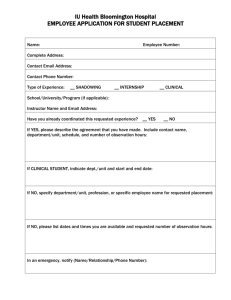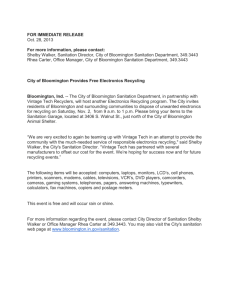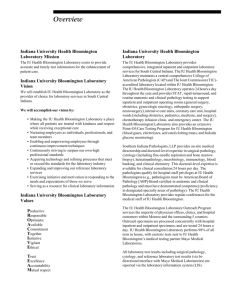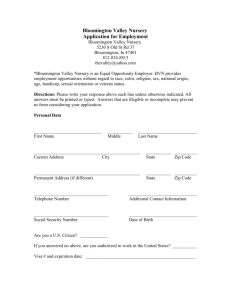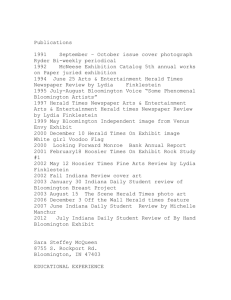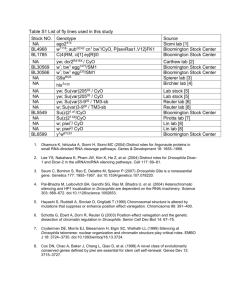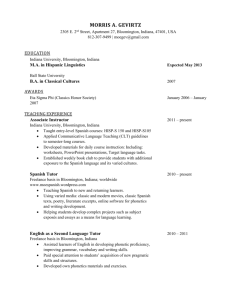IU Clinical Application
advertisement
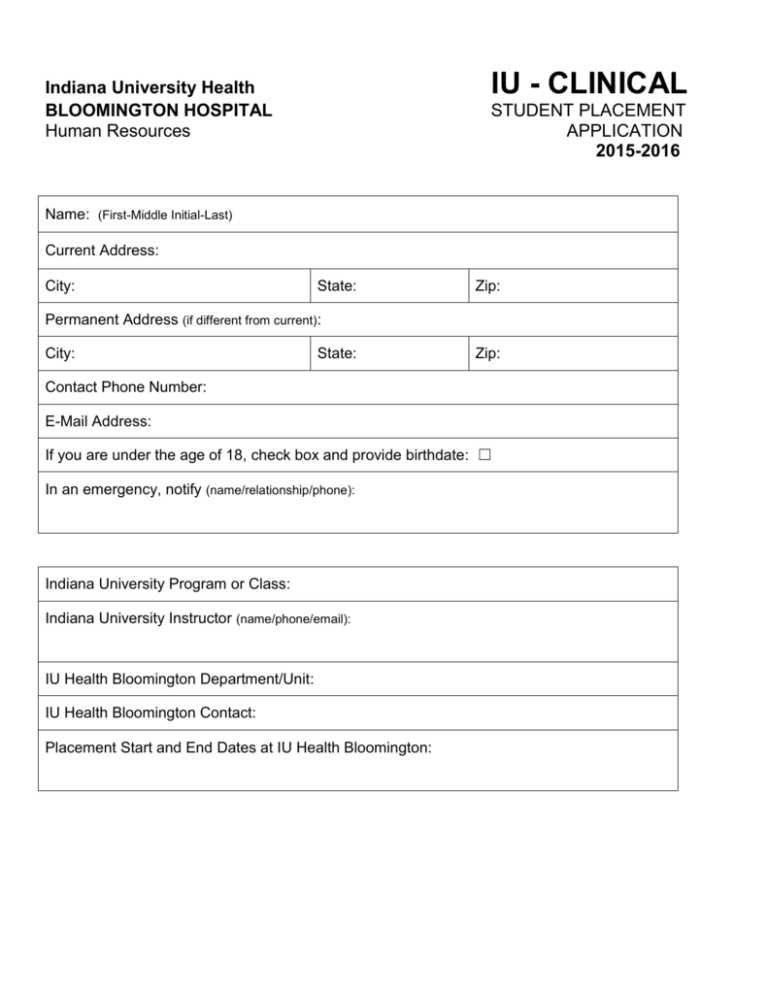
IU - CLINICAL Indiana University Health BLOOMINGTON HOSPITAL Human Resources STUDENT PLACEMENT APPLICATION 2015-2016 Name: (First-Middle Initial-Last) Current Address: City: State: Zip: Permanent Address (if different from current): City: State: Zip: Contact Phone Number: E-Mail Address: If you are under the age of 18, check box and provide birthdate: ☐ In an emergency, notify (name/relationship/phone): Indiana University Program or Class: Indiana University Instructor (name/phone/email): IU Health Bloomington Department/Unit: IU Health Bloomington Contact: Placement Start and End Dates at IU Health Bloomington: “NON-HOSPITAL PERSONNEL EDUCATION INSERVICE” QUIZ Read the Student Inservice document on website at iuhealth.org/bloomington/careers, click “For Students” then “Clinicals” Highlight or underline correct answers. 1. How do you report a fire? A. Call 44 or 911 to report (Depending on building location, check department specific plan for instructions). B. Yell down hallways to alert staff and visitors. C. Call the operator by dialing “0”. D. Don’t worry. Someone else will do it. 2. In the event that there is a power failure, which outlets are supplied with power from our emergency generators? A. All outlets have power C. The red outlets B. All the outlets on the first and second floors D. The green outlets 3. Hand washing is the single most important thing you can do to prevent the spread of infection. A. True B. False 4. If one link of the chain of infection is broken an infection will not occur. A. True B. False 5. Blood borne pathogen standard precautions were developed to protect workers. A. True B. False 6. You can enter an isolation room without wearing the identified personal protective equipment (PPE). A. True B. False 7. Multi Drug Resistant Organisms are easily cured by antibiotics. A. True B. False 8. What are the IU Health Bloomington Standards of Assurance? A. Friendly, Accessible, Smart, Tested C. Trust, Excellence, Accountability, Mutual Respect B. Quality, Communication, Environment, Accessible D. Timely, Effective, Accountable, Manageable 9. Who is responsible for the safety and security of all patients, visitors, and healthcare workers? A. Hospital Security and local police agencies C. All IU Health Bloomington workers B. The Volunteers D. Environmental Services 10. While at IU Health Bloomington, we can expect you to: A. Be trustworthy B. Implement the F.A.I.R. (feedback, assistance, inclusion, respect) approach C. Show respect D. All of the above 11. If something doesn’t look right, feel right or seem right, remove yourself from the situation and report it to someone of authority. A. True B. False 12. Accessing or disclosing sensitive patient or business information without a valid job related reason or direct treatment relationship with the patient is subject to disciplinary action, up to and including termination of employment or contract. A. True B. False 13. Laptops, iPads and other tablets that contain protected health information (PHI), personally identifiable information (PII) or other sensitive information should be password protected and encrypted. A. True B. False AGREEMENT & ACKNOWLEDGEMENT FORM ETHICS – PROFESSIONALISM I understand, like staff, I cannot initiate telephone calls, write notes, or arrange social interactions with patients. I will clearly define boundaries of staff-patient relationships during chance meetings in the community. Any pre-existing relationships with patients are to be discussed with the Director of the Department. Should a discharged patient attempt to develop a personal relationship with me postdischarge, I will clearly define again the staff-patient relationship boundaries and report this to the Director, who will provide specific guidance for professional conduct. Violation of this policy is grounds for termination of my placement experience. CONFIDENTIALITY As a Non-Hospital Personnel/Visitor at IU Health Bloomington, I recognize the extreme importance of confidentiality with respect to information concerning patients, IU Health Bloomington operations, and employees / Human Resources. I acknowledge that I will adhere to the provisions of the Health Insurance Portability and Accountability Act (HIPAA) and any other federal or state laws regarding confidentiality. I understand that violations of confidentiality will result in disciplinary action up to and including termination of contract, association, or appointment. Disciplinary action may also include the imposition of fines and other legal action pursuant to HIPAA and other applicable state and federal laws. I agree to report any violations of confidentiality that I become aware of to my supervisor, department director, member of the Senior Leadership Group, or the HIPAA Privacy Officer. I have read and understand the Privacy education provided in the Non-Hospital Personnel Education In-Service. HOLD HARMLESS The undersigned, being an adult, in return for being allowed to participate in certain IU Health activities agrees to assume the risks of participating in these activities and does herby agree to release, indemnify and hold harmless IU Health Bloomington, its employees, agents and representatives, from any and all damages of any nature whatsoever which the undersigned may suffer as a result of these activities such as being a passenger in an IU Health Bloomington vehicle, including an IU Health Bloomington Emergency Medical Transport Services emergency vehicle, owned or operated by IU Health Bloomington. The undersigned fully understands and assumes the risks involved in being a passenger in an IU Health Bloomington vehicle, including an Emergency Medical Transport Services emergency vehicle owned or operated by IU Health Bloomington, and assumes risk freely and voluntarily. These risks include an increased risk of injury and even death from being a passenger in a vehicle and/or in an emergency vehicle responding to an injury, accident or illness in an emergent fashion. This assumption of risk, release, indemnity and holds harmless is given by the undersigned in consideration of IU Health Bloomington granting permission to ride in an IU Health Bloomington vehicle, including an Emergency Medical Transport Services emergency vehicle, owned or operated by IU Health Bloomington for training, observation and evaluation purpose of benefit to the undersigned. READ THIS STATEMENT CAREFULLY All the information in this packet is true to the best of my knowledge and I understand this will become a part of my record. I also understand that any incorrect, incomplete, false or misleading statement or information by me herein will be considered possible cause for my dismissal from my placement experience. Furthermore, I understand that the Health Screening is not a physical examination. The hospital is not assuming responsibility for my continued medical care. I have read and understand the preceding policies. I am aware that if I violate an IU Health Bloomington rule or regulation my placement as a non-hospital personnel or visitor may be terminated immediately. Additionally, if I do not meet the required Dress Code Policy required of me on days in which I am scheduled, I will not be allowed to complete my duties on that day. I will remember that the department may make special accommodations for my placement. Therefore, if something happens and I am not available during the time that I have been scheduled for, then I MUST notify the department and/or my assigned IU Health Bloomington contact. Rescheduling arrangements may be discussed at this time or later. CLINICAL STUDENT / INSTRUCTOR NON-HOSPITAL PERSONNEL AGREEMENT I have read, acknowledged, and agree to abide by the following: check or highlight boxes and sign below ☐ I will keep all Protected Health Information and Business Operations Information confidential. ☐ I will follow all immunization, health, and safety standards. ☐ I will remember that we live and practice in a diverse community and have studied the Diversity Section included in the Student Inservice. ☐ I will hold harmless IU Health Bloomington and its representatives from any damages obtained during my placement. ☐ I will not use tobacco products or smoke on the IU Health Bloomington campus. ☐ I will follow the Professional Image and Dress Code Guidelines as detailed in this application. ☐ I have studied the National Patient Safety Goals included in the Student Inservice. ☐ I will remember the Standards of Assurance (quality, communication, environment, accessible) and will treat everyone that I encounter with respect. Please read carefully before signing I have read and understand the Student InService and have completed the Student Placement Application to the best of my ability. I voluntarily authorize Indiana University Health Bloomington to make a thorough investigation of my eligibility for a clinical experience. I agree to meet all immunization requirements before beginning my student experience. I understand that my placement may be terminated for any misinformation and/or omission of facts appearing on the application form, or for any violation of rules or regulations. Signature: ______ Date: ___________ (Your typed name qualifies as an electronic signature.) ** Please bring completed application and immunization records to: Student Placement Services Human Resources Building 709 W. First Street Bloomington IN 47403 (Human Resources is located behind IU Health Bloomington Hospital on First Street) e-mail: studentplacement_bloomington@iuhealth.org fax: 812-353-5447 Questions? Please contact Student Placement Services at 812-353-5527 or studentplacement_bloomington@iuhealth.org REQUIRED IMMUNIZATIONS CHECKLIST Bring immunization records to IU Health Bloomington Student Placement Services with this completed application. Non-Employees including clinical students are required to meet the same health requirements as employees of IU Health Bloomington Hospital. Health requirements are established in response to current CDC and Indiana State Department of Health guidelines and requirements. IU HEALTH BLOOMINGTON IMMUNITY, VACCINATIONS, AND TB TESTING REQUIREMENTS (One from each category) Hepatitis B: Documentation of completed 3 shot series or Documentation of a positive Hepatitis B Surface Antibody (blood test) or Signed Hepatitis B vaccine refusal form (available at IU Health Employee Health Services) MMR Evidence of Immunity: Documentation of laboratory (blood test) evidence of measles, mumps and rubella immunity (Positive Rubeola IgG, Mumps IgG, and Rubella IgG), or Documentation of two (2) doses of MMR (measles, mumps, and rubella) separated by at least 28 days Varicella (Chickenpox) Evidence of Immunity: Documentation of 2 doses of varicella vaccine given at least 28 days apart, or Documentation of laboratory (blood test) evidence of immunity (Positive Varicella IgG) Tetanus, Diphtheria, Pertussis (Tdap): Documentation of one dose of Tdap is a requirement for non-employees Note: Tdap is a one- time vaccination. Dtap vaccine cannot be accepted as the Tdap Tuberculosis (TST) TB Skin Testing: If needed and you are an accepted clinical student, the IU Health Bloomington Employee Health Services department can provide the TB test for no charge. Initial Testing: No History of Positive TST: Documentation of 2-step TB skin testing. A 0mm TST within the previous 12 months will be accepted as the first of two required TST. The second TST should be completed within 30 days of beginning work at IU Health Bloomington Hospital. Positive TB Skin Test History: Documentation of the positive TST and documentation of a chest x-ray (posterior and lateral) within 6 months of the start work date. Influenza: If you will be in an IU Health facility during the months of September through March, you must have the flu vaccine. Documentation must include: Date given, Manufacturer, Type of vaccination, Lot number, Expiration date, and Name and credentials of person who administered the shot. Beginning with the 2012 Flu vaccination program (usually September to April) all IU Health System healthcare personnel will be required to receive the Flu vaccination or request exemption for religious or medical reasons. Approved exemption forms are available in Employee Health Services. The start date for non-employees will not be delayed during the requests for exemption process. An appointed committee will review exemption requests with the following steps: The committee will respond within 30 days with approval, request for additional information, or deny the request. Non-employee has 14 days to appeal denials and/or provided the additional information. The committee will have 14 days to review the appeal/information received and render a final decision. If the request for exemption is denied after the process is completed the individual must take the flu vaccination or risk termination of placement. Professional Image and Look of Assurance: IU Health Bloomington As a shadowing, intern or clinical student you are expected to follow the dress code set forth by Human Resources Policy 8-115. In summary, you are required to dress in business casual attire. Items recommended include dress pants, khaki-type casual slacks, collared shirt, dress shirt, turtleneck, sweater, and clean & comfortable closed-toe dress shoes. Items NOT allowed under dress code include jeans, shorts, capri pants, sleeveless blouses, t-shirts, sweatshirts, athletic/tennis shoes, sandals, or any attire that shows undergarments. Jewelry and perfume scents should be kept to a minimum. Visible tattoos must be covered. Clinical students should wear their school uniform. If a school uniform is not required, clinical students will dress in business casual attire. Human Resources Policy 8-115 (condensed for student placement program): PURPOSE Our patients and their families expect and deserve the assurance that they have made the right choice by entrusting IU Health with their care. We provide this assurance though our unparalleled expertise, our welcoming environment, our convenient access to the services they need, and, most importantly, through our staff. The compassion, professionalism, clean hands and neat uniforms, help to provide our patients with the peace of mind that they’ve come to the right place. Our organization’s commitment to maintaining the Look of Assurance is an extension of the deep commitment that we have to providing our patients with the best possible care. It is also a reminder to our patients and guests that each employee is an important part of one of the best healthcare teams in the country. LOOK OF ASSURANCE STANDARDS Any time employees or students are wearing an IU Health badge or uniform, their appearance, attitude and behaviors are direct reflections on the quality of the care that we provide. It is essential that employees and students demonstrate professionalism and good judgment related to their appearance at all times. In order to help make sure that all employees and students interpret professionalism in a similar way, IU Health has adopted these standards. If one is ever in doubt about the appropriateness of their appearance, they should keep in mind that anything that could detract from our ability to deliver on the promise of assurance to our patients will not be permitted. The Look of Assurance standards apply to all full-time, part-time, supplemental and temporary employees, as well as students, volunteers, contract or agency personnel, staff from affiliated institutions, and employees providing services. Employees will exhibit courteous, conscientious and business-like behavior in the workplace consistent with IU Health’s Standards of Service. When having contact with patients and/or their families, employees introduce themselves and identify their role to help increase the comfort level of patients and their family members. STANDARDS THAT APPLY TO ALL EMPLOYEES The following Look of Assurance standards apply to all employees. A. Identification Badges 1. In order to assist patients, family members, physicians, visitors, and other employees in identifying persons affiliated with IU Health, employees are required to wear their identification badges at all times while on duty, except those employees restricted from wearing the badge while working in a sterile environments. 2. For infection control and safety reasons, employees may not wear an identification badge on a lanyard. 3. Identification badges are to be worn at chest or shoulder height. The identification badge should be on the outermost layer of clothing and not obscure the IU Health logo emblem on the employee’s uniform. 4. Employees may only use an Indiana University Health badge reel, or a clear clip to attach the identification badge to their uniform or clothing. B. Personal Hygiene 1. All employees are required to be clean and maintain appropriate personal hygiene with regard to their body, hair and nails. 2. Hair must be a natural color and style (not, for example, fluorescent colors or stripes), neatly combed or brushed and not interfere with the employee’s ability to provide safe patient care in any way. Braids and dreadlocks are acceptable, provided they are clean, neat and do not obstruct the employee’s face. When providing direct patient care, hair longer than shoulder length must be contained so it will not interfere with patient care or customer service. Beards, sideburns and mustaches must be neatly trimmed. 3. Hands and nails must be well groomed, with nails trimmed not to exceed 1/4 inch from the tip of the fingers. Nails may be polished with clear or modest colored polish only. If worn, the polish must be free of chips. Employees with direct patient contact may not wear artificial nails of any kind, including nail art. C. Other 1. 2. 3. 4. 5. 6. 7. Jewelry must be kept to a minimum (e.g., no more than 2 earrings per ear) and may be banned in some areas to safeguard against injury or transmission of infection. Non-traditional body and facial jewelry (e.g., tongue, eyebrow, lips, and nose piercings, gauges, bars, ear-to-ear chains, etc.) may not be worn while on duty and any resulting piercings should be covered by a flesh-colored plug. Jewelry should be conservative in style and free of edges that might scratch a patient. For employees providing direct patient care, dangling jewelry is not to be worn (bracelets, earrings, and necklaces). Cosmetics, if worn, must be modest. While on duty, tattoos must be covered by modest flesh colored make up, clothing, or flesh colored selfadhesive dressings provided by the employee. Scented body lotions, fragrances, perfumes, and colognes should not be used to excess and may not be worn in patient care areas. Skirts should not exceed a height of 3” above the middle of the knee. Capri pants should not exceed a height of 3” above the ankle. Hosiery or socks must cover any exposed part of the leg and be worn with all outfits. ADDITIONAL GUIDELINES FOR NON-UNIFORMED EMPLOYEES 1. Employees who do not wear an IU Health uniform must be dressed in professional wear at all times. Official IU Health logo-wear meeting these criteria is acceptable. 2. Employees who are dressed in professional wear must wear professional style shoes. Mesh or leather athleticstyle shoes (Nike, New Balance, Adidas, etc.) are not permitted. 3. Employees who are not in roles subject to an IU Health uniform should avoid wearing a combination of clothing similar to an IU Health uniform. 4. Employees not designated to wear scrubs or lab coats may not elect to do so and should be dressed in attire consistent with their role. INAPPROPRIATE ATTIRE The following items are examples of inappropriate attire. However, this list is not all inclusive: 1. Clothing that is soiled, wrinkled, torn, noticeably worn, frayed, too tight, too loose, or too long. 2. Scuffed, dirty, unpolished, untied, visibly worn shoes, slippers, or flip flops. 3. Open toed shoes by employees working in positions requiring universal precautions (example: patient bedside, clinic office personnel placing patients in a room, etc.). 4. Shorts (except when worn during an outdoor health fair or other similar event), bare legs, leggings, stretch pants, tight slacks or scrub pants with the waists rolled down. 5. Bare back tops, halter-style tops, midriff length tops, or form-fitting materials 6. T-shirts without a scrub top or cover-up jacket. 7. Sweat shirts, sweat pants and sweat suits (includes, but is not limited to, silk and nylon materials). 8. Thermal underwear, Henley’s, any clothing with waffle-type material or any “see-through” material worn as the outer/visible layer. 9. Undershirts with visible logos, sleeveless fashions that expose underwear, exposed midriff, tying shirttail or arms at the waist. 10. Plunging necklines or shirts which expose chest hair or cleavage. 11. Painter/carpenter or bib overalls. 12. Underwear garments visible outside of the uniform or through the uniform. 13. Any color of any denim apparel including, but not limited to, skirts, dresses, jumpers, shirts, pants vests and jackets. 14. Sunglasses indoors (without medical reason or for outdoor work). 15. Any attire which would be worn for sports activities. 16. Any slick fabric, form fitting clothing, of the variety that is often used for athletic apparel. 17. Clothing or accessories bearing pictures or writing that states or implies nonprofessional, illegal, distasteful, or suggestive language/activities. 18. Clothing which advertises a service, business, or non-health related association or other enterprise. 19. Head coverings except when associated with professional, medical, or religious rationale or are required for reasons related to practice or State Board of Health Regulations; nursing school cap is optional. Note: appropriate head coverings may be worn for outdoor health fair or other similar events. CONTRACTORS, AGENCY, AND STUDENTS Contractors and agency staff in patient-facing roles must follow the uniform standards for that role; however, contractor and agency uniforms should not contain the IU Health logo. Students will wear the uniform assigned by their school. If they do not have a uniform assigned to them, they will wear professional wear. ACCOMMODATION REQUESTS Employees with documented medical or religious exceptions may be exempted from the applicable portions of these standards. If an employee has questions or concerns about medical or religious exceptions to these standards, he/she should follow up with their manager or consult Human Resources for further assistance.
